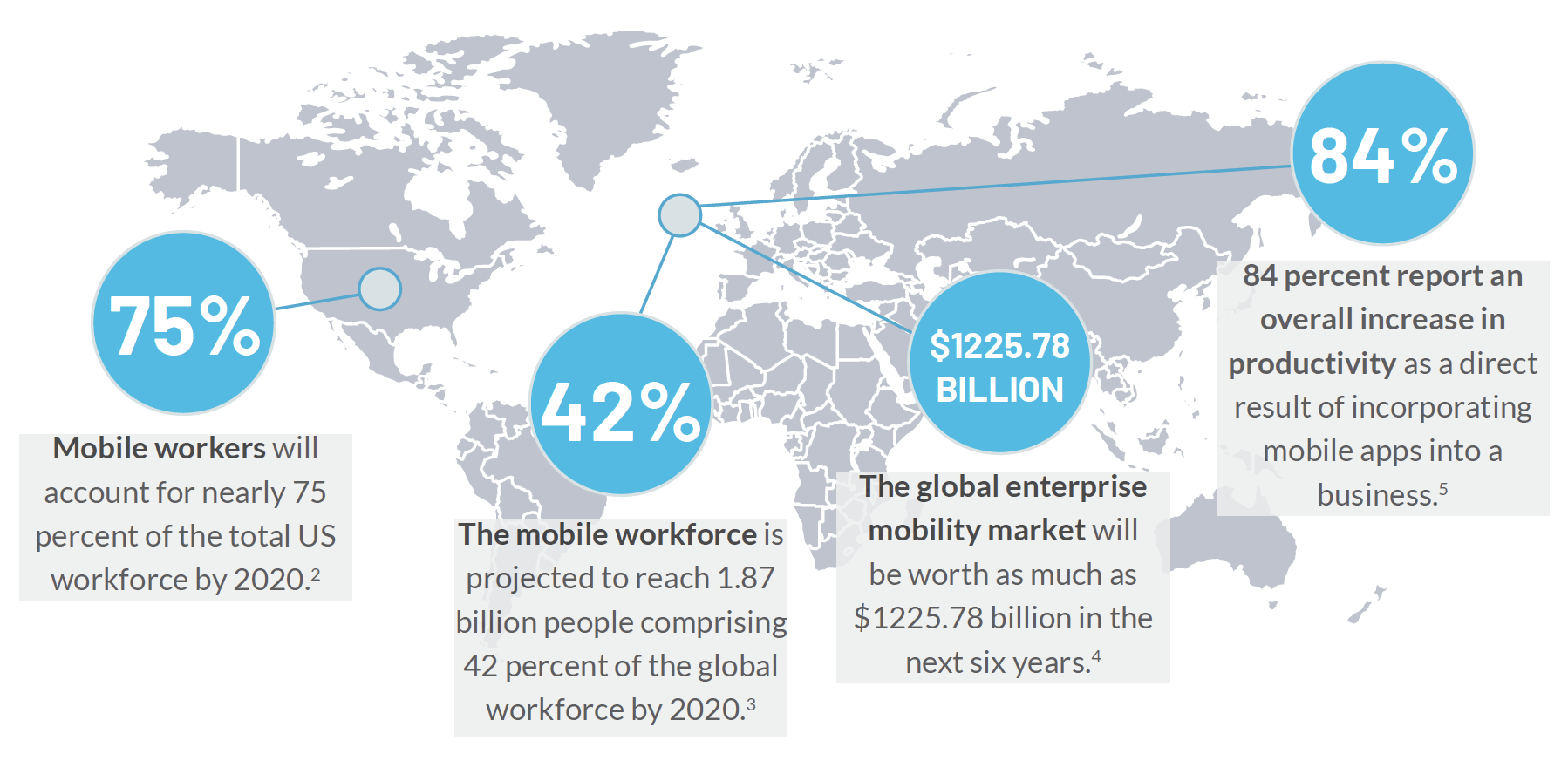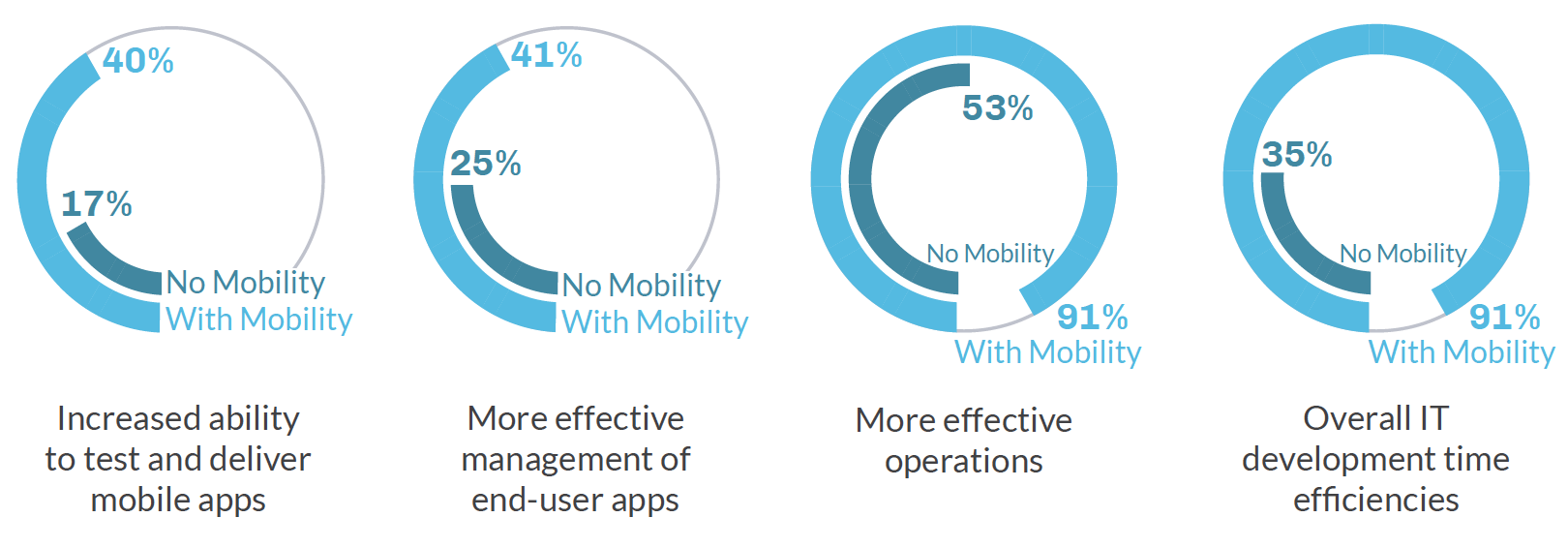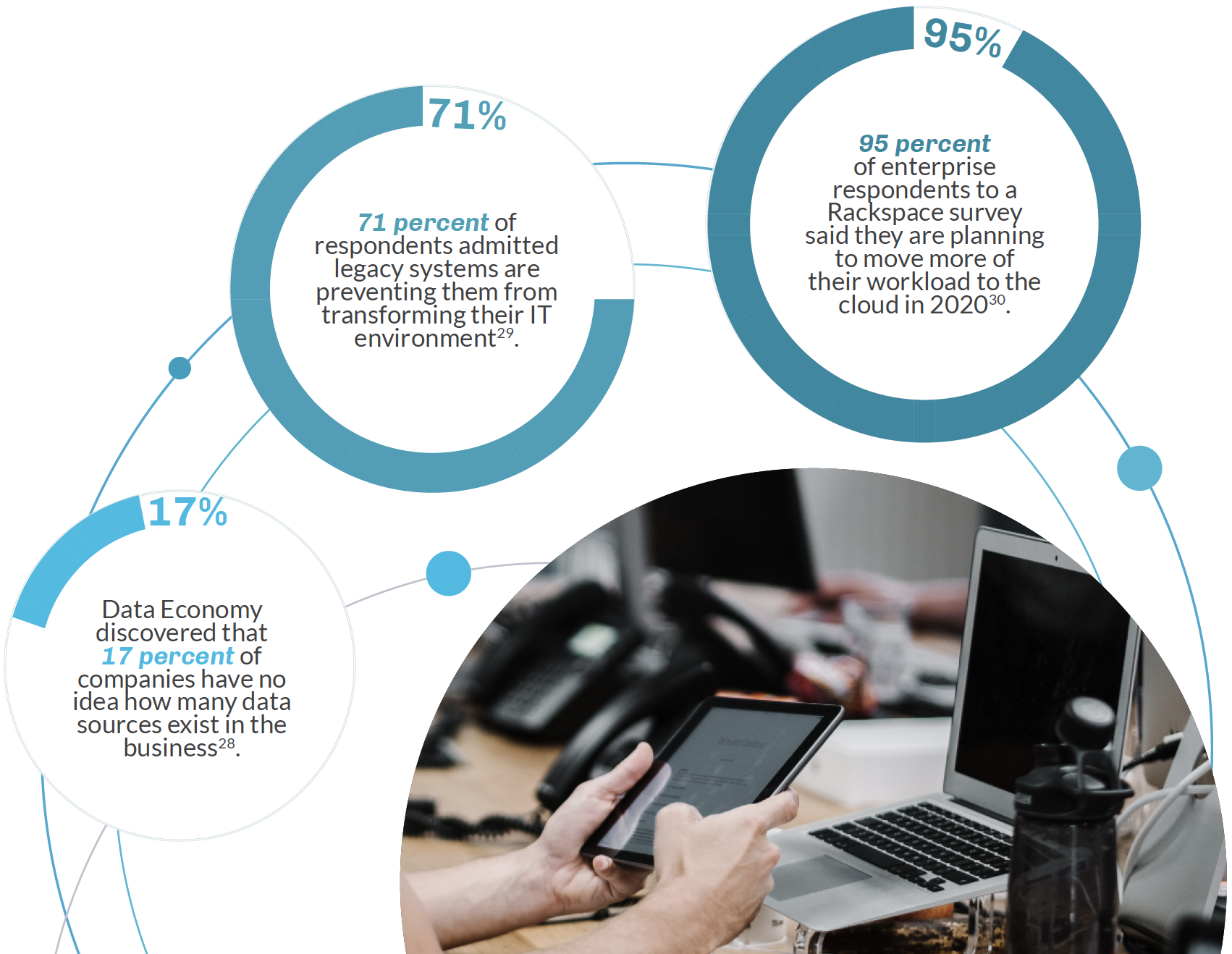Enterprise Mobile App Development
Enterprise mobility initiatives – particularly mobile app development – have become more urgent moving into 2022. As mobility continues to reshape entire industries to a notable effect, many companies are pushing for large-scale transformation to capture the benefits of enhanced mobility.
Enterprises are no longer just in competition with other large enterprises, but increasingly with mobile-first companies that are disrupting industries and capturing market share. These fast-moving, agile startups have less red tape, mobile-first products and services, and mobile workforces available at the tap of a button: and they are coming after your customers.
Enterprise Mobility has the potential to be the most transformative trend in business, affecting every employee and customer while making the organizations that successfully implement mobile initiatives more competitive and more successful. Business mobility is no longer a nice-to-have; it’s imperative, and it’s pushing businesses to rethink fundamental processes or risk becoming obsolete.
This guide provides an overview of the changing enterprise mobility landscape, and the challenges organizations are facing as they adapt to the rapidly evolving mobile ecosystem. It will discuss the growing importance of mobile apps through both an employee- and customer-facing perspective and how they are integral to enterprise operations and customer experience. This guide will also apply an analysis of the current and future mobile trends and provide recommendations on how to navigate key enterprise mobility challenges. It is meant to guide decision makers and members of teams responsible for organizational mobile strategy, covering key topics that include:
- The acceleration of competition from mobile-first disruptors that challenge the status quo
- Shifts in employee and customer behaviour toward mobile work, engagement and consumption
- An analysis of the ROI for early innovators in the enterprise mobility space
- Key challenges to enterprise mobility initiatives such as resourcing, technical capabilities, legacy system integration, and security
- Recommendations for creating a mobile strategy that aligns with organizational goals and supports a broader mobile vision
The Modern Workforce Is Mobile
Research indicates that employee-business applications affect every part of an organization; 81 percent of roughly 2,200 enterprise respondents to a Forbes survey state that mobility directly impacts company growth and will increase in importance in the coming years.

- Mobile workers will account for nearly 75 percent of the total U.S. workforce by 2020.
- The mobile workforce is projected to reach 18.7 billion people comprising 42 percent of the global workforce by 2020.
- The global enterprise mobility market will be worth as much as $1225.78 billion in the next six years.
Enterprise is currently competing with a surplus of companies with a mobile workforce available to customers at their fingertips. The emergence of the service-for-hire model pioneered by companies like Uber means that organizations not only have to target customers on mobile but also enable their workforces to compete with the changing nature of labor that mobile technologies are facilitating.
By equipping the workforce with mobile technology, companies are putting decision making and proactivity in the hands of their employees.
For the digitally transformed enterprise, this change will become so influential it will be a source of competitive advantage. It has become more consequential for enterprises to think critically about the ways in which mobility will affect their business in the near and longer-term, and the skills necessary to identify and act on rapid market changes. Companies that fully embrace mobility and prioritize employee-business apps, making them easily accessible to employees, will create an indisputable edge in the market.
Enterprises are prioritizing mobility initiatives
Enterprise mobility solutions are a top priority for more than 73 percent of businesses in the USA, Canada, and the APAC region.
43 percent of IT leaders believe that their budgets for mobility solutions will increase in the coming years.
Top 5 technology investments:
- Artificial Intelligence: Global spending on AI is expected to reach $79.2 billion by 2022
- Data & Analytics: Global spending on data and analytics is expected to reach $129 billion by 2022
- Cloud Services 7 Infrastructure: Global spending on cloud systems is expected to reach $370 billion by 2022
- Mobile App Development: Global spending on mobile app development is expected to reach $1.7 trillion by 2021
- Internet of Things (IoT): Global spending on IoT is expected to reach $1 trillion by 2022
For early adopters, enterprise mobility has proven ROI...
62 percent of IT leaders with a well-defined mobile strategy achieve ROI in 12 months or less.
Organizations that have achieved their business mobility goals were able to bring new revenue streams online 35 percent faster than companies only focused on individual productivity needs.
Companies with business mobility achieve greater IT operational gains than companies without.

Bold innovators create a bigger economic advantage
Overall, top-performers in the enterprise space are developing much more innovative products and services than their peers. While most companies’ mobile transformation activities involve modifying existing products and processes, winning companies focus on developing entirely new digital offerings and services. Companies that excel in enterprise mobility initiatives do so by taking advantage of emerging digital ecosystems early, concentrating product development efforts on brand-new digital offerings, and restructuring existing business processes to be mobile.
Percentage Of Enterprises’ Digital Offerings, By Area Of Focus

Percentage Of Enterprises’ Digital Capital Allocated, By Objective

Enterprises are recognizing the benefits of agile
For many organizations, agility holds a high standing on the list of priorities. In response, enterprises are beginning to restructure operations in multiple areas across the organization to become more agile. On top of undergoing internal transformations, more organizations insist that outsourced partners are proficient in agile software delivery.
Top 3 benefits of agile development
- Ability to manage changing priorities
- Project visibility
- Business/IT alignment
According to the 13th State of Agile Report:
- 97 percent of enterprise respondents report practicing some degree of agile process.
- 73 percent of enterprise respondents report having planned or started a DevOps project.
- 46 percent of respondents are using agile methods to manage outsourced development projects.
- 40 percent of respondents indicate they plan to begin using agile practices in outsourced projects in the next 24 months.
Challenges in Enterprise Mobility
Capabilities and Resources
Capabilities and resourcing talent are among the most pressing challenges for enterprise app development and deployment. Enterprise organizations typically don’t possess qualified teams for in-house mobile app development. Increasingly, enterprises have to compete for talent with mobile-first startups that are challenging their business. A Gartner CIO survey found that lack of guidance to help identify and source required roles and skills needed to create mobile apps was one of the top priority issues listed.
Enterprise organizations are continuing to source and hire for multiple app development roles, but only 15 percent of respondents to an Outsystems survey described recruitment efforts as easy. Actually, for many mobile specialties, recruitment was described as hard or very hard, and despite a growing demand for talent, only 36 percent of organizations report having larger mobile app development teams year-over-year.
Finding the right talent is a key enabler for capturing the value of mobility initiatives. Compared to others, top-performing enterprises devote much more of their workforce to mobility plans. It’s not just the magnitude of investment that differentiates the successful enterprise, though. Top-performers are also much more flexible in their use of mobile talent, continually designating these employees throughout the organization to enable a more agile distribution of resources and a better alignment between qualified staff and strategies.
Large organizations are typically lacking in basic app development lifecycle skills such as user experience (UX) design, quality assurance, mobile-specific back-end data integration, and mobile-oriented security needs.
Only 26 percent of enterprises are adopting an in-house development approach; 55 percent are successfully delivering apps using mixed sourcing models.
The pace of mobile evolution will continue to outstrip the supply of people who can deliver effective solutions.
Legacy Systems
Legacy systems continue to be a major challenge for organizations across the enterprise space. On top of modifications and updates that have to be made to support enterprise mobility initiatives, many legacy platforms are being “sunsetted,” which will force enterprises to modernize their applications25. Emerging, mobile-first competitors don’t face the same legacy system issues and in many cases have less complex security challenges than their enterprise counterparts.
Cloud services have been a significant area of investment in recent years, and enterprise organizations will continue to pour money into modernizing IT systems in the coming years. Cloud-specific spending is expected to grow at more than six times the rate of general IT spending in 2020.
With that said, companies are continuing to fall into the trap of thinking that transferring legacy IT systems to the cloud translates to a mobile transformation strategy. In short, organizations are failing to derive value from cloud migration. Modernizing legacy systems will require more than a “lift-and-shift” approach.
Gartner predicts that every dollar spent on digital business innovation through the end of 2020 will require enterprises to spend at least three times that to continuously modernize the legacy application portfolio.

Satisfying corporate demand for mobile apps
There is a relentless demand for custom mobile applications and meeting this demand is proving to be challenging for organizations. In 2019, 42 percent of enterprise companies aimed to develop 50 or more mobile apps. Driven by digital innovation and market differentiation initiatives, the pressure for mobile app development is growing; however, companies still face plenty of barriers to mobile app innovation.
Innovation vs. Maintenance
While research shows that the companies focused on developing entirely new digital offerings and services achieve a competitive advantage, a majority of mobile apps slated for development in 2020 are either replacements or updates to existing products rather than business innovation. Overall, the division of app development projects falls at 65 percent of maintenance work and only 35 percent of work lined up for net new products. Additionally, industry analyst reports estimate that maintenance projects consume roughly 75 percent of IT resources.
One circumstance making innovation initiatives difficult to prioritize over maintenance projects is speed. The ability to innovate quickly and test mobile products efficiently are critical success factors, but development times are still long.
Long Development Times

Alongside agile adoption, companies are integrating a number of customer-centric practices to increase delivery speed for applications.

Other challenges
There are a number of other obstacles cited by enterprise decision-makers that are affecting the ability to implement enterprise mobility initiatives, including project complexity, establishing the necessary support infrastructure, and keeping up with the pace of change:
- Legacy system integration/APIs missing or needing improvement: 16%
- Fuzzy/changing requirements: 15%
- Testing/QA: 14%
- Security: 13%
- Data privacy concerns: 12%
- Lack of technical skills: 10%
- UX/UI design: 9%
- Deployment coordination with IT operations: 9%
Mobilizing the Enterprise: Recommendations for moving forward
Legacy Systems
Legacy systems exist everywhere; the major challenge is interfacing with them and figuring out how to pull the right data from them. Where enterprises tend to struggle is finding a way to take legacy systems that have been created for disparate purposes, centralizing them, and allowing people across the organization to interface with them.
An effective solution when facing this challenge is creating an API layer that sits on top of legacy systems, which allows centralization. This layer speaks to the legacy systems so that the systems and data are available to various facets of the business; anyone who needs to, can communicate with the legacy system through the API layer.
Creating an API layer also allows organizations to choose what they expose so they can allow different groups – employees, partners, and customers, for example – to access specific subsections of the systems based on their needs.
APIs can uncover data across diverse IT systems, both legacy and modern. An API can be used to extract data and connect them to complex analytics systems. Deciding which APIs to build requires identifying and mapping the most critical journeys and then determining the required APIs to unlock important data. It also involves identifying APIs that will facilitate a more agile, test-and-learn operation.
Agile API lifecycle for continuous improvement

Analyze individual API needs
- Map individual API requirements against roadmap, cross-reference API need against existing catalog
- Publish all APIs through discovery portal (in the roadmap and nice-to-have requests)
Build/ Execute/ Reuse
- Design, develop, and test APIs. Where possible reuse and extend existing APIs instead of building net new
Deploy API
- Publish API to the gateway, provide documentation, and communicate to the user community
Operate the API
- Maintain and fix the API as necessary. Provide support to project teams that are leveraging the API
- Monitor during operation: security, usage, business value, metering and throttling
Review API Performance
- Each sprint, API metrics are reviewed to determine next steps (continue operation, modify, retire), integrating learning from monitoring
- New versions may need to be published, following this same lifecycle
Retire API
- When APIs become obsolete or requirements change significantly, retire the current version and support any partner teams to migrate
Security
As mobilization accelerates, it’s critical for organizations to boost defense systems and ensure information systems are well protected. Security should be an underlying aspect of any holistic mobile strategy. While enterprise mobile security is a complex issue to tackle, there are a number of focus areas that can lay the foundation for securing sensitive data and systems. If you are using a bring your own device (BYOD) model, a Mobile Device Management (MDM) solution is essential. These solutions create a sandbox where your enterprise applications live, let you set compliance requirements, remotely wipe data, and more. If your organization is issuing the devices, you have much more control over what employees can access and limit how the device is used. For example, you can disable native apps, force the use of whitelisted apps, have remote device locking functionality, and more.
Data encryption, certificate underpinning, and strong authentication measures are also imperative to a well-rounded mobile security strategy and are typically included in MDM solutions. Importantly, your security strategy should be formalized and present early in the development lifecycle, rather than a consideration that is addressed in later stages.
Implementing employee-facing applications
There is an undeniable shift in how companies are managing everyday work processes – a shift towards becoming a truly mobile workspace. The ability to make the transition to a mobile-first company is becoming a serious competitive advantage. Employee-centric mobile applications are creating more productive and desirable work environments, but that’s just the beginning. By making mobile applications available to employees, companies are putting decision-making and proactivity in the hands of the end-user. Mobile technology, as it becomes more advanced, will become a central factor in a company’s operations and performance.
Understand Resourcing and Capability Needs
The most pressing challenge enterprises face in their mobile app development initiatives is a gap in expertise. Often, these organizations aren’t conscious of the fact that mobile app development requires an entirely different set of competencies than web development or other traditional IT systems. The reality is that organizations often lack the necessary expertise in-house to effectively execute the planning and development of a mobile app.
The ability to make the transition to a mobile-first company is becoming a serious competitive advantage
Mobile app development and delivery requires more than a team of mobile engineers. You will need mobile architects, UI and UX designers, and product owners in addition to engineers. Furthermore, mobile engineers tend to turn over more quickly because there is a high demand for them in the market, and they are accustomed to a different work culture than most enterprises offer. Organizations must have a plan that allows them to adapt to change.
Consider a mixed-sourcing model
In its analysis of enterprise application trends, Gartner recommends adopting this approach, stating that 55% of organizations are successfully delivering apps using this model.
This approach can be highly beneficial, particularly for enterprises that are just beginning with mobility projects, as it combines external consultants and specialists with in-house talent. This approach can help reduce internal costs while also allowing internal team members to gain the knowledge needed for future initiatives.
55 percent of enterprise organizations are successfully delivering mobile apps with a mixed-sourcing model.
Learn from your employees
A central contributor to a successful enterprise mobility transformation is making the most of employee expertise. Front-line employees know their work inside out and companies often introduce mobile solutions to replace employee expertise rather than supplementing it, which proves to be a significant challenge in user adoption. Forcing mobile solutions into the daily lives of employees won’t work in the long-term. Instead, it’s crucial to empathize, understand, and collaborate with frontline users in the design process. When enterprise teams partner with employees to design mobile solutions it creates important employee advocates for new business applications. Identifying and working with employee experts will minimize adoption challenges and change management efforts when the product is ready for deployment.
Resist digitizing the status quo
Throughout product planning, it’s essential to avoid creating mobile solutions for the tasks employees already do easily. A successful approach is to use the design process to carry out in-depth user research, pinpoint actual efficiency needs, and find opportunities to invent. In this process resist and challenge the “this is how we’ve always done it” mentality. Taking existing processes, digitizing them, and presenting them in mobile form is an easy fix, but hardly ever translates to improvement. Re-envisioning the entire process from the user’s perspective is the only way to capture real value and improvement from enterprise mobility activities.
Adopt a focused approach
Given the size of enterprise organizations, determining where to begin with employee-facing apps is often a major challenge. The reality is that there is no catch-all solution given the needs of different departments and the sheer variety of roles and objectives.
The best approach is to start small with an app or apps that solve particular problems for a set of users; addressing a very specific need. For example, a company that provides field services may create an app that allows service technicians to view schedules, report on appointment status, and interface with the back-end system directly from the application. This approach allows organizations to remain focused and ensure things work very well for a particular set of users, prior to rolling out larger initiatives for other areas of the organization.
Use a design thinking process to carry out indepth user research, pinpoint actual efficiency needs and find opportunities to invent.
Use mobile for appropriate tasks
 A mobile solution is not always appropriate for every situation. Desktop solutions may still be necessary for work processes that demand time and attention. Context is key. Making the appropriate decisions about whether a mobile solution fits the context requires extensive research and observation. Only through research can you innovate work processes with mobile channels to the best advantage.
A mobile solution is not always appropriate for every situation. Desktop solutions may still be necessary for work processes that demand time and attention. Context is key. Making the appropriate decisions about whether a mobile solution fits the context requires extensive research and observation. Only through research can you innovate work processes with mobile channels to the best advantage.
Take advantage of consistency
Mobile technology is ubiquitous and everyone is familiar with basic interaction models. Excellent enterprise products take advantage of the principles of consistency. By testing new mobile products with end-users, product teams can identify and incorporate user experience ideas that users already know and enjoy using. Everyone uses a smartphone in their personal lives, and creating enterprise applications that are simple and familiar will reduce time-to-market and long-term costs.
Implementing customer-facing applications
For businesses with customer-facing products, implementing a mobile app strategy is essential to overall success in a market where a mobile-first approach has become standard for verticals across the board. Customer-facing apps reflect a brand and act as major touchpoints between a company and its customers. Not only do these apps add value to a user’s daily routine by solving a specific pain point, but they have the potential to build brand loyalty, boost engagement, and increase revenue.
Organizations seeking to create customer-facing enterprise apps need to build a culture of continuous delivery to keep up with rapidly changing customer demands and provide the best user experience possible.
Understand Resourcing and Capability Needs
The necessary talent for customer apps can often be different from employee-facing apps. Since these applications are your brand, there is a heavy emphasis on UX and customer delight, so design talent is imperative. With customer-facing apps, you need product managers who understand mobile entirely; understand your business and its problems; and understand how to solve these problems. These people are very difficult to find, so like employee-facing enterprise apps, customer-facing apps present enterprises with similar resourcing difficulties. Therefore, a mixed-sourcing model is something that should be considered.
Focus on UX and customer delight
The delivery of customer-facing apps is different from internal apps. Your app is a key customer touchpoint and you need to be cutting-edge and offer a seamless user experience. Design, customer delight, and adding value is typically much more heavily emphasized in contrast to employee-facing apps.
Many companies are incorporating design thinking practices into existing product development routines and experiencing notable benefits. Design thinking supports innovation by observing and considering multiple solutions to a single problem. The core principle of design thinking asserts that a user-centric approach to product development encourages innovation, which leads to market differentiation and competitive advantage. Great mobile experiences follow the five stages of design thinking: empathize, define, ideate, prototype, and test. These stages, however, are not necessarily sequential and can often operate in tandem, repeating in an iterative cycle. The stages of the design thinking process should be considered as separate roles that advance the design’s entirety. The end goal is to arrive at a cohesive understanding of the product’s purpose and audience.
Think Native
With native mobile app development, the app is created and optimized for a specific platform. Native apps demonstrate an extremely high level of performance. Native apps are very fast and responsive because they are built for that specific platform and are compiled using platforms core programming language and APIs. As a result, the app is much more efficient. The device stores the app allowing the software to leverage the device’s processing speed. When users navigate through a native mobile app, the contents and visual elements are already stored on their phone which means load times are quick. With a native app, it’s not only the coding language that is native but also the architecture and UX. If the app is designed to perform the way the platform expects it to, the performance will always be superior.
Advantages of native apps
- Native apps receive complete support from app stores and the overall app marketplace. Distribution in app stores helps with discoverability.
- Native apps are interactive, intuitive, and run more smoothly in terms of user input and output.
- Native development allows developers to access the full feature set of the selected operating system.
- The user experience of native apps is far superior to web apps or hybrid apps. To the user, the flow is more natural because of each mobile operating system’s specific UI guidelines and standards.
- A native app must be approved by its respective operating system which assures quality, security, and device compatibility.
Understand your costs
Customer-facing apps are typically more difficult to build and take more time, for a variety of reasons: a broader range of platform and device support; more emphasis on design; the need for native builds, and various other reasons. You will also need a marketing and user acquisition plan in place. Budgets should be congruent with your success benchmarks for the application.
While the cost of a mobile app is different for every project, planning helps depict a more accurate price range. The goal is to minimize fluctuations between initial product requirements and what’s actually built in the development stages. Change is inevitable in mobile app development, and without proper planning, it’s very easy for change requests to cause your team to lose sight of the original product concept. External forces like user requests, emerging technologies, and competitive threats can all crop up during development causing development teams to rethink product requirements. Internal forces like unexpected user research and test results can also have the same impact on your change management strategy. Problems arise when unanticipated change is executed without considering the impact on the original purpose of the mobile app. The key is to build flexibility into the process and direct change back towards achieving the originally defined product goal.
Conclusion
Here are the key takeaways form this enterprise mobility guide:
- Competition from disruptors are capturing market share and challenging the status quo – to ensure economic viability, enterprises need to act on mobility initiatives now.
- Customers and workforces are increasingly mobile and enterprise organizations must adapt fast.
- Top-performers in the enterprise mobility space are developing much more innovative products and services than their peers.
- Key challenges to enterprise mobility initiatives include resourcing, legacy system integration, security, and fulfilling the demand for mobile apps.
- Enterprises must adopt a strategy that aligns with organizational goals, is purposeful and focused, and supports a broader mobile vision.


